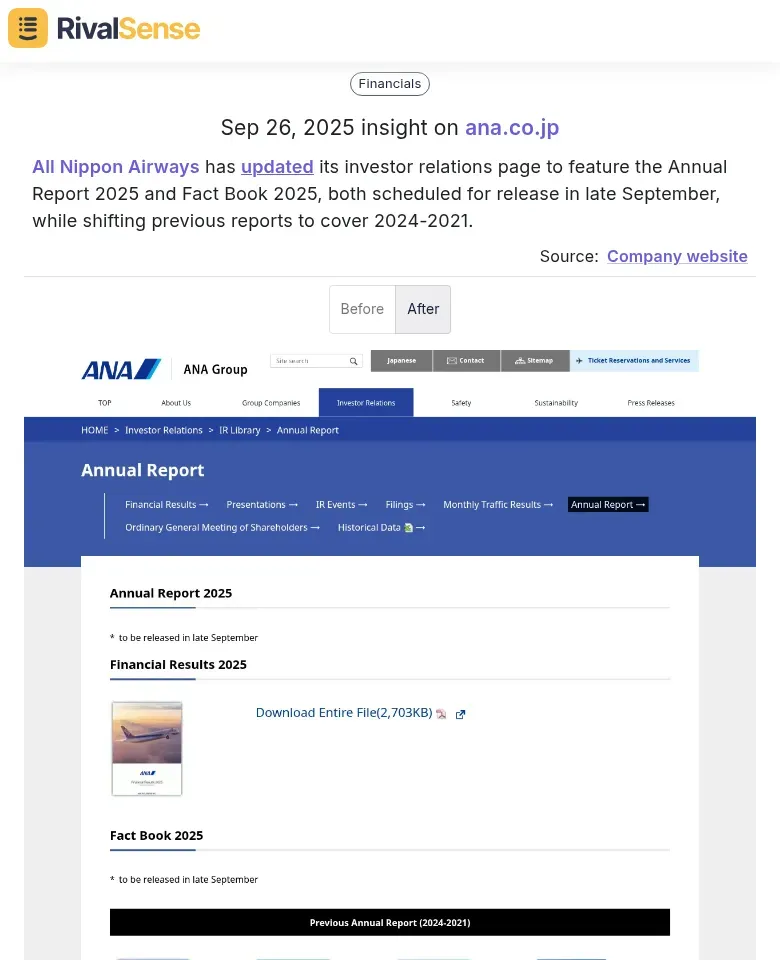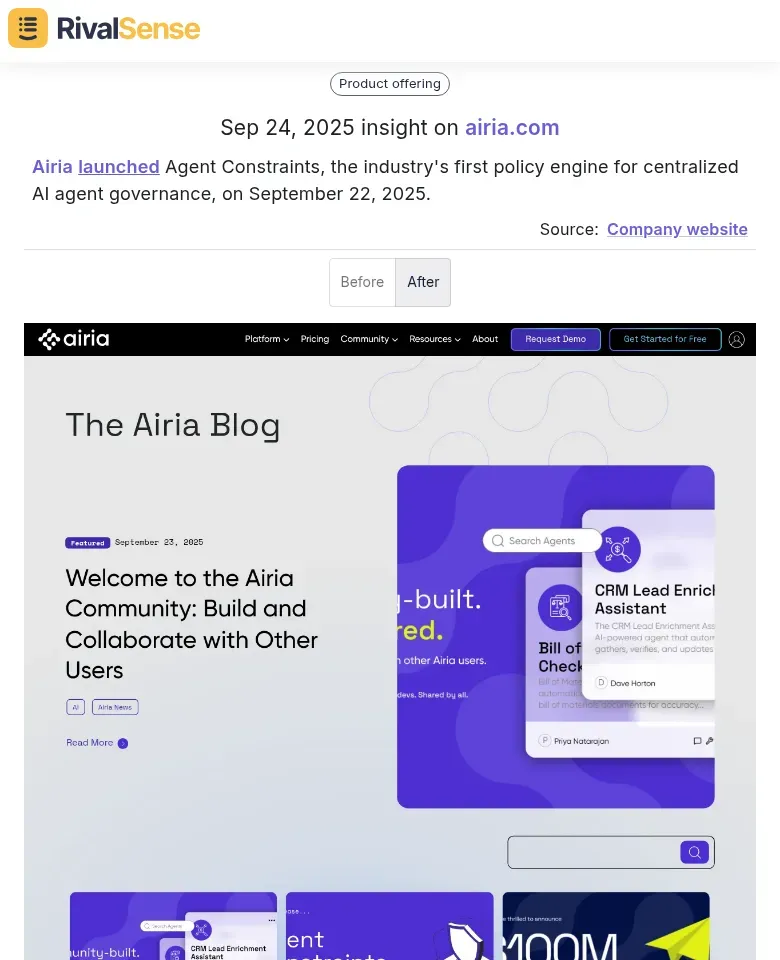Leveraging Competitor Website Changes for Proactive Key Account Management
In today's dynamic B2B landscape, monitoring competitor website changes is a powerful tool for proactive key account management. These updates—such as new product launches, pricing adjustments, or service expansions—offer real-time insights into market shifts, enabling you to anticipate client needs before they arise. For example, if a rival adds an enterprise-tier feature, it signals a push upmarket, allowing you to tailor your account strategies to counter this move. Competitive intelligence derived from website tracking helps you stay ahead by revealing broader business developments, like mergers or rebranding, that directly impact account planning. To leverage this, regularly audit competitor sites for changes in content, structure, or calls-to-action; set up alerts for instant notifications; and correlate updates with client feedback to refine your approach. By integrating these practices, you can transform website monitoring into a strategic asset for sustaining key account relationships.
Learning from Financial and Reporting Updates: Timing and Transparency Insights
Staying ahead in key account management requires keen observation of competitor activities. One critical area is their financial disclosures, which can reveal underlying strategies. Financial and reporting updates, such as annual reports or quarterly filings, are goldmines for key account management. By interpreting scheduled releases, you can forecast competitor priorities—for instance, a surge in R&D spending in a report may signal a new product focus, allowing you to preemptively tailor your outreach.
For example, RivalSense recently tracked that All Nippon Airways has updated its investor relations page to feature the Annual Report 2025 and Fact Book 2025, both scheduled for release in late September, while shifting previous reports to cover 2024-2021.

Tracking such financial updates is valuable because it helps you anticipate strategic shifts, such as resource allocation or market focus changes, enabling proactive account adjustments. Look for shifts in public documentation, like changes in risk factors or executive commentary, which often reveal strategic pivots, such as a move from enterprise to SMB markets. Leverage timing patterns by aligning your key account touchpoints with competitor announcement cycles; if a rival always launches updates in Q1, schedule your demos just before to highlight your advantages.
Practical steps:
- 📅 Subscribe to SEC filings or investor relations pages for alerts
- 📊 Analyze year-over-year changes in financial metrics to spot trends
- 🗓️ Use a calendar to map competitor release dates and plan outreach 2-4 weeks prior
This proactive approach ensures your messaging is timely and relevant, turning competitor transparency into your strategic edge.
Gleaning Product Innovation Clues from Feature Enhancements
Product feature enhancements are often subtle yet revealing indicators of competitor direction. In the realm of key account management, monitoring these changes can uncover strategic priorities that impact your accounts. By analyzing integration improvements, such as smoother API connections or new third-party app support, you can gauge a competitor's emphasis on user experience and product quality.
For instance, RivalSense insight shows that The Figma integration now includes live previews that display translations in the final layout to improve quality and reduce guesswork.

This type of insight is valuable because it highlights a focus on user-centric innovation, allowing you to assess how competitors are addressing customer pain points and adapting your own solutions. Track these updates systematically to identify trends, like a shift towards mobile-first features, which may indicate evolving market demands.
To extract actionable insights, follow this checklist:
- 🔍 Maintain a log of competitor feature releases monthly
- 📂 Categorize changes (e.g., integrations, UI updates) to spot patterns
- 💡 Assess how enhancements address common pain points—such as reducing manual data entry—and use this to refine your account solutions
Practical tip: Use tools like RivalSense to automate tracking and receive alerts on relevant changes, ensuring you stay ahead in adapting your strategy.
Decoding Strategic Moves Through New Product Launches
New product launches provide a clear window into competitor ambitions and market positioning. For key account managers, these events are opportunities to anticipate shifts and refine strategies. By analyzing first-to-market innovations, you can gauge their investment in emerging technologies—like AI or blockchain—revealing R&D focus and market confidence.
A recent RivalSense example: Airia launched Agent Constraints, the industry's first policy engine for centralized AI agent governance, on September 22, 2025.

Monitoring such launches is valuable because it helps you identify emerging trends and regulatory adaptations, enabling you to proactively address client concerns or spot collaboration opportunities. Track launch timing: a rushed release may indicate defensive moves against threats, while well-timed announcements can hint at partnership readiness or market expansion.
Practical steps to turn launches into intelligence:
- 🚀 Monitor launch announcements via news alerts and social media
- ⚖️ Assess feature uniqueness: Is it incremental or disruptive?
- 🎯 Analyze messaging for target audience shifts or value propositions
- 🔔 Use tools like RivalSense to track changes and set alerts for real-time insights
This approach helps anticipate competitive threats or identify collaboration opportunities, turning launches into actionable intelligence.
Practical Framework for Integrating Website Monitoring into KAM Processes
Integrating website monitoring into your key account management processes requires a structured approach to maximize effectiveness. Start by establishing a systematic framework that aligns with your account goals. First, identify key competitor websites relevant to your accounts—focus on those targeting similar industries or offering complementary solutions.
Use tools like RivalSense to automate tracking of changes in pricing, product updates, case studies, or leadership announcements. Set up alerts for specific pages, such as pricing or features sections, to capture real-time updates.
Next, translate observations into actionable insights. For example, if a competitor lowers prices, assess the risk to your account's loyalty and prepare a value-based response. If they launch a new feature, identify cross-selling opportunities by highlighting your unique advantages.
Create a quick-action checklist for your team:
- ✅ Document changes as they occur
- 📈 Analyze impact on account goals within 48 hours
- 🛡️ Develop mitigation or growth strategies promptly
Finally, build a culture of continuous intelligence by integrating findings into regular account reviews. Hold monthly meetings where teams share competitor updates and discuss implications. Encourage proactive monitoring by rewarding insights that lead to account growth or risk avoidance. This approach ensures KAM teams stay agile, turning competitor moves into strategic advantages.
Ready to transform your key account management? Try RivalSense for free to automate competitor tracking and get your first detailed report today—stay ahead with weekly insights on product launches, pricing changes, and more!
📚 Read more
👉 Airline Competitor Thought Leadership Analysis Cheat Sheet
👉 4 Quick Hacks to Analyze Competitor Products for Key Account Growth
👉 Competitor Analysis in Action: Insights from OpenAI's Recent Activities
👉 Mastering Competitor Pricing Models: A Strategic Guide for B2B Leaders
👉 5 Key Account Management Mistakes Influencer Platforms Must Avoid
